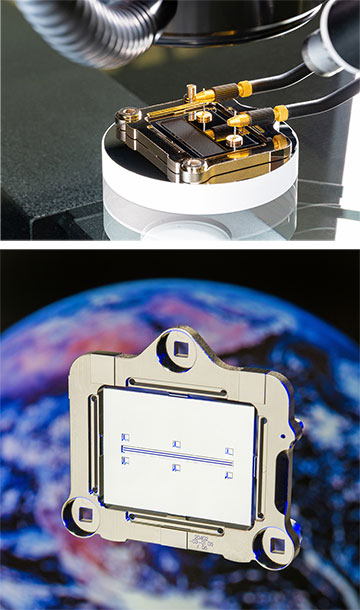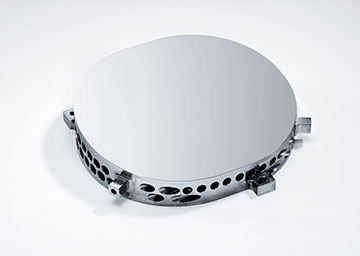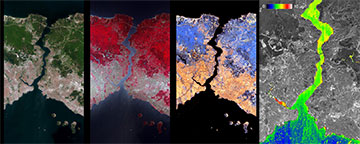Left: True-color (left), visible and near-infrared (second left) and short-wave infrared (second right) images of Istanbul, Turkey, taken by EnMAP. Right: EnMAP image displaying chlorophyll concentrations of Bosporus Strait. [Image: © DLR; CC BY-NC-ND 3.0] [Enlarge image]
Late last April, just short of a month after the spacecraft’s launch, researchers at the German Aerospace Center (DLR) received the much-anticipated initial set of test images from Germany’s first hyperspectral-imaging satellite, the Environmental Mapping Analysis Program (EnMAP). The test set, the subject of which was the Bosporus Strait in Istanbul, Turkey, contained not only a true-color image of the region but also infrared images that informed the researchers about Bosporus’ algae concentrations.
Those early results rested on optics manufactured by two Fraunhofer institutes in Germany—the Fraunhofer Institute for Applied Optics and Precision Engineering IOF in Jena and the Fraunhofer Institute for Microengineering and Microsystems IMM in Mainz. The two Fraunhofer arms contributed components including a high-precision double-slit module, metal mirrors and various optical layers for the telescope and spectrometer.
Measuring spectra from space
EnMAP’s goal is to reveal the state of the planet Earth through hyperspectral imaging. The technique captures, for each individual imaging pixel, a continuous spectrum of the sunlight reflected by Earth’s surface. That rich signal can reveal various materials’ spectral signatures that are invisible to human eyes. By combining imaging with spectral data, the satellite aims to provide information about the environment, ecosystems and natural resources—and humans’ impact on them.
Central to EnMAP’s operation is its hyperspectral imager, which collects spectra between 420 nm and 2450 nm for every 6.5 nm in the visible and near-infrared region and every 10 nm in short-wave infrared—yielding 242 spectral channels in total. Simultaneously, an imaging spectrometer takes images with a spatial resolution of 30 m × 30 m.
Double-slit conundrum

Top: Double-slit module during precision assembly in the coordinate-measuring machine. Bottom: The resulting double-slit module. [Image: © Fraunhofer IMM/T. Hang]
Creating optical devices that operate on such scales is not an easy feat, however. For one thing, the wavelength range covered by the hyperspectral imager is too wide for a single spectrometer to record. To solve this issue, researchers at the Fraunhofer IMM manufactured a high-precision double-slit module that directs the incident light into two detectors.
But having a double-slit module posed another problem: because the two slits are set slightly apart, the second slit sees the same point of Earth a fraction of a second later than the first one. To allow the overlay of the recorded data and achieve the 30×30-m2 spatial resolution, the offset between the two slits had to be identified with maximum precision.
The Fraunhofer IMM researchers decided that, to achieve that extreme precision, they had to produce slits with a graduated cross-section instead of rectangular slits, which turned out to be less mechanically stable. Even though the design change came after Fraunhofer IMM’s partners had already performed extensive simulations and analyses, the team was not deterred, said Stefan Schmitt, group manager at Fraunhofer IMM, in a press release. “Things like this happen from time to time when breaking new ground, so we were prepared for it.”
Mirror, mirror in the satellite

Precisely shaped, light-weight metal mirror that the Fraunhofer IOF team manufactured. [Image: © Fraunhofer IOF]
Another optical device that needed special attention was metal mirrors. “For space applications, the mirrors not only need to have an extremely smooth surface and be shaped with an exceptional level of precision,” said Stefan Risse, project manager at the Fraunhofer IOF, in a press release, “they also need to weigh as little as possible.”
To achieve the smoothness and precision required, the researchers deposited an X-ray-amorphous nickel–phosphorus alloy on aluminum. The properties of the resulting films were similar to those of glass. The films were then further machined using ultra-precise diamond tools and polished for local shape correction and surface-roughness smoothing.
The Fraunhofer IOF researchers also employed their patented techniques to achieve a lightweight mirror design. The final structure resembled a capital, an architectural element of a church—cross bores meeting at right angles connected the front and rear of the mirror, and the resulting column structure supported the surfaces.
In total, the Fraunhofer IOF team manufactured 11 ultra-precise metal mirrors. As a final step, the optical surfaces were coated with layers of protected silver for the visual spectral range and sputtered gold for the infrared range.
Future ahead
Right now, as the EnMAP satellite circles the Earth at about 650 km above the planet’s surface, the onboard optics are still being calibrated and adjusted. But in two to three months, the spacecraft is scheduled to enter its operational phase, with scientists collecting real data about human impacts on the environment. Based on the initial test images, hopes are high.
“These first images already give us a very good idea of what researchers around the world can expect,” said Sebastian Fischer, EnMAP project manager at DLR’s German Space Agency, in a press release. “They show that EnMAP can make a major contribution to highlighting the consequences of climate change and counteracting the ongoing destruction of the environment.”

